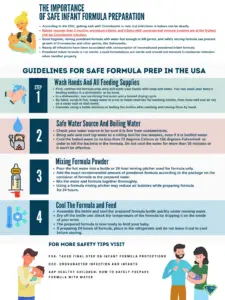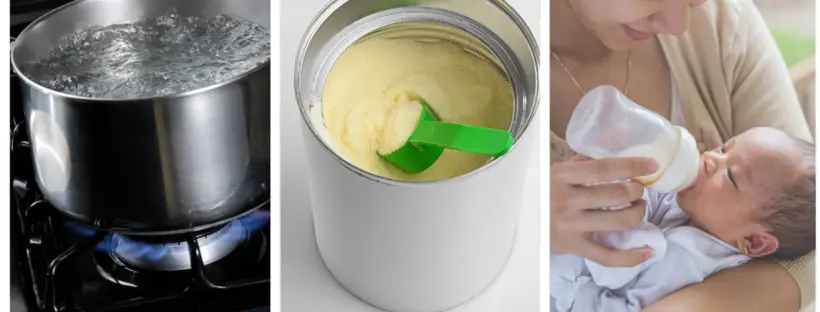Written by Jody Segrave-Daly, MS, RN, IBCLC
Boiling water for powdered infant formula preparation is one of the most conflicting and confusing topics for parents. Our governing bodies such as the CDC, WHO, WIC, AAP, and FDA, all have varying recommendations for preparing formula.
Seventy-five percent of infants in the US will receive some infant formula by 6 months of age. Safe infant formula preparation education is very important to ensure babies are fed safely for optimal growth and health outcomes. Parents have shared some of the educational materials they received for formula preparation, and there were vast differences ranging from a one-page handout to a complete step-by-step instruction booklet. Most parents said they were not told to boil water.
Infant Formula Regulation In The United States
Infant formula products in the US have the most rigorous regulations in the world. In 1980 Congress passed the Infant Formula Act and the 1986 Amendment which, along with the current edition of the Infant Formula Program, established nutrient requirements for all infant formulas. The American Academy of Pediatrics’ Committee on Nutrition develops the nutritional standards and are used by the Food and Drug Administration to develop infant formula regulations.
The Infant Formula Act of 1980 is one of the most specific and detailed acts ever passed by Congress. It establishes nutrient requirements, defines adulteration, provides for establishing nutrient and quality control procedures, prescribes recall procedures, and specifies inspection requirements.
Monitoring Infant Formula Manufacturing
The Food and Drug Administration (FDA) monitors the manufacturers of infant formulas. They have a lengthy list of requirements found here. Nutrient content, nutrient quantity, nutrient quality control and assurance, sampling, labeling, handling, and microbiological analysis are required for every batch made.
The shipment of infant formula has specific regulations that range from packaging, wrapping, and stacking during transit. An official inspection certificate number is also required to ensure they are safe before reaching the consumer. There is mandatory monitoring and recalls for any complications related to formula.
For comparison, the required components for formulas internationally are set by the Codex Alimentarius, a joint food standards program overseen by the Food and Agriculture Organization of the United Nations and WHO. Individual countries can also set additional guidelines.
There are Three types of formula products available
- Ready-to-feed liquid formula is the safest way to feed your baby. It’s made with the water already added and processed to be sterile, which means free of pathogens. Ready-to-feed formulas are the most expensive option and may not be affordable for many families.
- There is also a concentrated formula liquid that can be prepared by adding safe water; this eliminates the pathogens that may be present in formula powder. This is the second most expensive option, but it is still costly.
- Powdered formulas are less expensive and require more time to prepare, but can be prepared and used safely when following recommended guidelines.
If infant formula is tightly regulated and tested for Cronobacter and Salmonella what is the purpose of boiling water?
Boiling water is not about making the water source safe, it’s about killing any potential pathogens in the formula powder itself. According to the Food and Drug Administration (FDA), formula powder is always tested for Salmonella and Cronobacter before distribution, but it is not sterile. It can become cross-contaminated at home from unclean hands, the formula scoop, from unclean surfaces when preparing the formula, formula storage, and usage after the expiration date.
Feeding babies is critically important for optimal health outcomes. There are many factors to consider when preparing infant formula, and safety is of utmost importance. Formula-fed babies are consuming nothing but formula during a critical period of rapid growth and development.
What is Cronobacter?
According to the CDC, Cronobacter (which used to be called Enterobacter sakazakii) is a germ that can live in very dry places. Cronobacter has been found in dry foods, like powdered infant formula, powdered milk, herbal teas, and starches. It has also been found in sewer water. Cronobacter infections are often very serious—even fatal— for babies.
Thankfully, Cronobacter infections are very rare. The CDC receives reports of four to six infant infections per year in the United States. Babies who are less than 3 months old, premature, and/or immunocompromised are especially vulnerable to this bacteria because of their immature immune system, and they may not be able to fight off the infection even with the best modern medicine.
Boiling water guidelines contradict each other
A 2019 published paper in Pediatrics called Mixed Messages on Formula Mixing discusses concerns about the different boiling recommendations.

The recommendations differ when it comes to the temperature of the water—whether one should add formula powder to boiling water, add formula powder to water that has been boiled and cooled, or never boil water at all.
What are the authors’ concerns?
According to Baby-Friendly USA, parents who deliver their babies in their accredited hospitals and are formula feeding are required to receive educational guidelines for formula preparation from the WHO. The WHO has the most rigorous and cumbersome guidelines and the authors question if they are based on developing countries that do not have a clean water supply or adequate refrigeration.
The WHO’s recommendation has 12 steps for one bottle preparation, and boiling water 8 or more times a day to prepare a formula bottle greatly increases the risks for burns in comparison to the rare Cronobacter infections.
Every day, 300 young children are taken to the emergency department for burns caused by hot water. The US has the highest rate of burns in the industrialized world, and burns are the second leading cause of death for children less than 5 years of age.
Are We Doing More Harm Than Good with the WHO recommendation?
A risk–benefit analysis is necessary to develop evidence-based recommendations for safe infant formula preparation. Parents in the US have access to refrigeration and clean water, so they can prepare a batch of formula once daily and store it safely for 24 hours while lowering burn risks.
Our recommendations for preparing powdered formula:
- If using powdered infant formula you must determine if your water source is safe.
- Powdered formula is used by most parents because it is the most economical and is what the WIC program provides. Formula-fed babies who are less than 3 months of age, born premature, or are immunocompromised are most vulnerable to infections.
- It’s much safer and realistic to boil, cool, mix and store formula safely once every 24 hours for families who have access to refrigeration, which is the majority of American parents.
- The temperature of the refrigerator should be no higher than 41°F or 5°C and should be monitored daily for optimal storage protection.
The steps:
Wash Hands And All Feeding Supplies
- First, sanitize the formula prep area and wash your hands with soap and water for 20 seconds (sing Happy Birthday twice). You can wash your baby’s feeding bottles in a dishwasher or by hand.
- In a dishwasher, use sanitizing/hot water and a heated drying cycle.
- By hand, scrub in hot, soapy water in a tub or basin reserved for washing bottles and nipples, then rinse well and air dry on a clean rack or dish towel.
- Consider using a bottle sterilizer or boiling the bottles after washing and rinsing them by hand.
Safe Water Source and Boiling Water
- Check your water source to be sure it is free from contaminants.
- Bring safe and cool tap water to a rolling boil for two minutes, even if it is bottled water.
- Cool the boiled water to no less than 70 degrees Celsius or 158 degrees Fahrenheit in order to kill the bacteria in the formula. Do not cool the water for longer than 30 minutes or it won’t be effective.
Mixing Formula Powder
- Pour the hot water into a bottle or 24-hour mixing pitcher used for formula only.
- Add the exact recommended amount of powdered formula according to the package on the container of formula to the prepared water. *Note: It’s typically one loosely packed and a level scoop of formula powder mixed in 2 ounces of water.
- Mix the water and formula together thoroughly. *Note: After mixing, the volume liquid volume increases by about a half-ounce for every 2 ounces and 1 scoop of powdered formula.
- Using a formula mixing pitcher can ease mixing large volumes and may reduce air bubbles when preparing a 24-hour formula batch.
Cool The Formula and Feed
- Assemble the bottle and cool the prepared formula bottle quickly under running water to body temperature—about 98 degrees Fahrenheit—if it is to be fed to the baby immediately.
- Dry off the bottle and check the temperature of the formula by dripping it on the inside of your wrist.
- The prepared formula is now ready to feed your baby.
- If preparing 24 hours worth of formula, place the pitcher in the refrigerator immediately and do not leave it out to cool before storing.
What about the powdered formula where manufacturers’ directions say to not boil the water?
Boiling water will inactivate probiotics in the powder. Ready to feed formula has intact probiotics.
Very important tips for formula prep
- Proper formula preparation is important. Adding too much water dilutes essential nutrients, and can impact a child’s growth. Serious electrolyte imbalances can occur and place your child in a critical life-threatening situation.

Additional resources
What Kind Of Water Is Safe For Mixing Formula Powder For My Baby?
https://pediatrics.aappublications.org/content/130/5/e1076?download=true
http://Infant Formulas | American Academy of Pediatrics
https://www.jpeds.com/article/S0022-3476(19)30515-3/fulltext
https://www.cdc.gov/cronobacter/infection-and-infants.html
Safe Breastfeeding Plan:
How To Prepare For Supplementing When Breastfeeding Your Baby In The Hospital
For breastfeeding, formula feeding, pumping, combo-feeding, or tube feeding consults:
http://fedisbest.org/resources-for-parents/one-on-one-online-consultation-with-jody-segrave-daly-rn-ibclc/
To join our parent support group:
- If you need infant feeding support, we have a private support group– Join us here.

3 thoughts on “Do Parents Need To Boil Water For Powdered Infant Formula Preparation in the United States?”